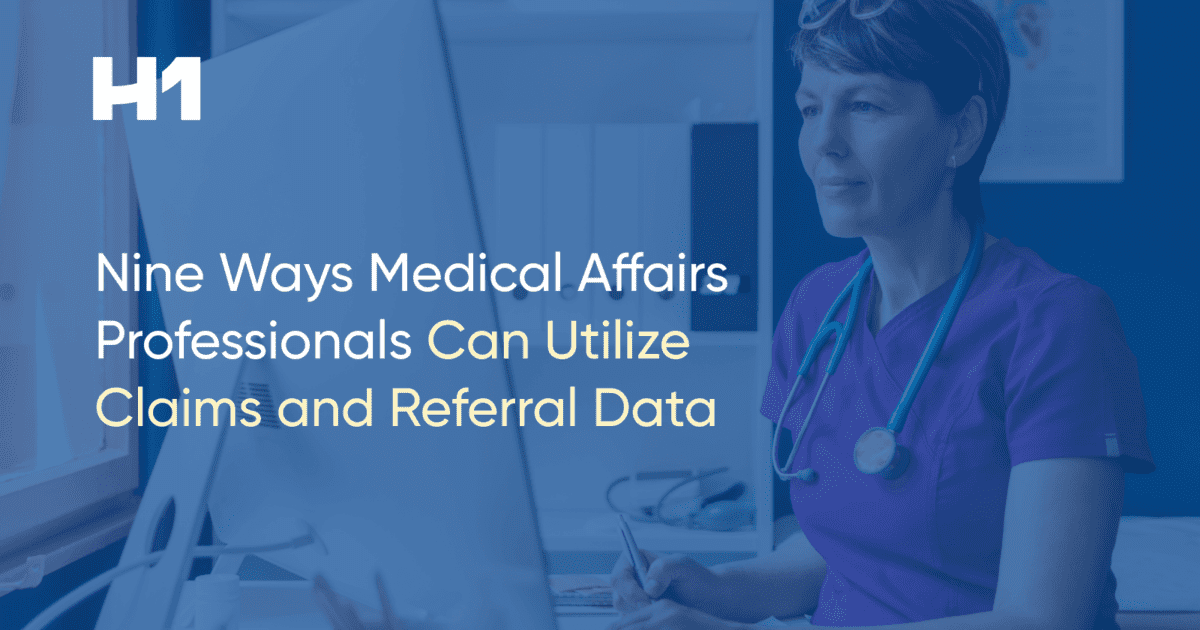9 Ways Medical Affairs Can Use Claims and Referral Data

In a recent interview an experienced medical affairs professional reminisced about the days when key opinion leader selection was a difficult and time consuming activity, which often relied on established connections and lists of experts that had been successfully engaged before.
Today, medical affairs can access large data sets with information about the professional activities of millions healthcare providers (HCPs), powerful computers and advanced algorithms to crunch all that data allowing them to identify healthcare professionals with skills and experiences in specific therapeutic areas and for different types of engagement.
In that large universe of data, medical claims and physician referral data play a particularly critical role: they paint a clear picture of a physician’s everyday work, treatment experience and professional relationship with peers. As such, claims and referral data don’t just help medical affairs professionals identify the most suited external experts from a large pool but also support other critical activities across the organization.
Here are nine use cases for claims and referral data.
Using Claims Data to Identify Clinical Trial Sites
Selecting the wrong site for a clinical trial is an expensive mistake to make – and a fairly common one.
“11% of sites in a given trial fail to enroll a single patient, 37% under-enroll, 39% meet their enrollment targets, and 13% exceed their targets.” – Tufts Center for the Study of Drug Development
Successful site selection is an involved process. Finding an experienced principal investigator (PI) is just the first step, that investigator also needs to be affiliated with a facility that has the patient base to meet the study’s enrollment goals.
While publications, previous clinical trial experience and Open Payment Data can help identify qualified PIs, establishing whether the healthcare facility supports recruitment of sufficient patients is harder to determine.
Claims data can fill that information gap: based on the ICD and HCPCD codes clinical development and medical affairs teams can determine how many relevant diagnoses and procedures are performed at the facility and how many patients might be eligible for trial participation. Information about the PI’s referral network provides an overview of an expanded group of physicians that might be able to refer trial participants.
Using the highly granular claims and referral data in combination with comprehensive information about the designated PI, pharmaceutical companies can optimize site selection by focusing on facilities with large relevant patient populations. Reaching out to the referral network of the PI and their colleagues, e.g. by providing educational material about the drug and the unmet medical need it addresses, can increase the likelihood of successful enrollment.
Claims Data Support Decentralized Clinical Trials
Decentralized clinical trials (DCTs) are conducted remotely using telemedicine as well as mobile or local HCPs. PI and patients therefore do not have to be at the same facility. Traditionally decentralized trials have been used in therapeutic areas in which patient follow-up for trials could more easily be done remotely, e.g. neurology, but wearables, in-home devices and artificial intelligence, among other innovations, have made it possible to expand the therapeutic areas that can utilize DCTs.
DCTs decouple the location of the PI from where eligible patients are located – but those patients still need to be found and recruited. Using patient level claims data, organizations can identify geographic areas with an above average number of eligible patients and focus their recruiting efforts there. This more targeted recruitment effort saves cost and increases the chance of meeting enrollment goals in a timely fashion.
Identify Physicians with Specialized Experience
Finding physicians who treat patients with highly specialized medical needs is one of the most challenging tasks. Rare diseases are an obvious but not the only example. Take hypertensive diseases (ICD I10-I15): one of the most frequent diagnosis, hypertensive diseases are associated with a host of specialized diagnoses with infrequently used ICD codes. Analyzing nuances in the codes can help identify narrowly defined patient populations and the physicians who treat them. Medical science liaisons (MSLs) are then able to specifically engage these physicians with relevant information and educational materials for them and their patients.
In addition, claims and referral data can be used to:
- Optimize MSL territories and MSL allocation. Traditionally MSLs were deployed to areas where thought-leaders for their drug and/or therapeutic area were located. Claims data make it possible to ascertain where the patients are. This may result in re-allocation of resources or change in territories.
- See changes and trends in treatment patterns, e.g. are there any procedures that are being used more than in the past? What treatments are they replacing? What insights can be gained from that shift and what can medical affairs do to educate the HCP community about it?
- Detect patterns in claims to identify physicians who do not follow established treatment patterns and engage them with educational information.
- Uncover opportunities for strategic engagement with HCPs. One example is identifying geographic locations where a disease is particularly prevalent and reaching reach out to HCPs in that area with educational materials.
- Look for discrepancies between the number of ICD codes and number of patients. If the data shows that the same patients undergo the same diagnosis or procedure on a frequent basis this might indicate an opportunity to provide information and educational materials to the HCP.
- See patterns in referral data, e.g. does an HCP not refer to a specialist everybody else is referring to for a complication associated with the disease? Insights like these allow MSLs to reach out and educate that HCP about the disease and complications.
These nine use cases illustrate the broad usefulness of claims and referral data for pharmaceutical organizations, especially medical affairs. If you have questions about any of these or would like to discuss how these data can help your organization address challenges, please contact us here. Also check out Connecting the Dots between Patients, Physicians and Payors.

 HCP Universe
HCP Universe Trial Landscape
Trial Landscape